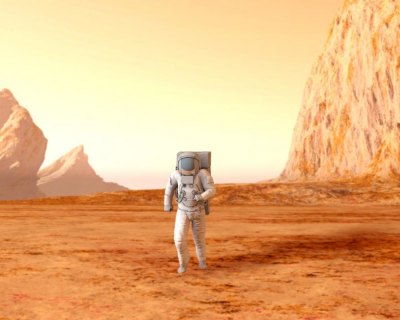Three takeaways about the red planet

Lujendra Ojha was a lead author in the research about water on Mars announced Sept. 28. He earned his undergraduate degree from the University of Arizona in 2012 and is a grad student at Georgia Tech. The 25-year-old's website lists his research papers and academic credentials and prominently features a picture of him apparently playing electric guitar. See his website here.
Another author on the paper is Mary Beth Wilhelm, 25, a Cornell graduate and Ph.D. candidate at Georgia Tech who works in the planetary science branch at NASA Ames Research Center in California. Her career at NASA began when she was 16, according to her website.
Of course, the two authors benefited from centuries of groundwork by other scientists. And before anyone sets foot on Mars, researchers still have more homework to do. During a press conference Sept. 28, scientists offered insights about the space agency’s journey. Here are three takeaways:
Once we get there, we may be in luck.
“All of the scientific discoveries that we’re making on the surface of Mars … are giving us a much better view that Mars has resources that are useful to future travelers,” said John M. Grunsfeld, NASA’s associate administrator for the science mission directorate. “When you have water, you know, what’s water? Hydrogen and oxygen. That’s what we make rocket fuel out of.”
In addition, he mentioned the presence of perchlorates, also used by the space program and found on Mars. "In principle," he added, "you could make solid rocket fuel."
We may be polluting Mars.
“We try and clean our spacecraft as best as we can,” Grunsfeld said. “The surface of Mars is really a very harsh place. It’s got ultraviolet light from the sun that bakes the outside of the spacecraft and if you want to kill microbes on Earth, you take a UV light and you kill the microbes.”
Even so, microbes are tenacious, he said. “It is impossible to kill them all. So we do the best job that we can, and then we send our spacecraft into areas that we think are the least sensitive to the possibility of contaminating extant Mars life.”
Scientists, he says, are being careful not to send a spacecraft to Mars in an attempt to detect life, “and find out that we detected the Earth life we took with us.”
“It’s important to realize that NASA’s approach to exploration is not Star Trek,” said Jim Green, planetary science division director for the space agency. “It’s not 'go where no man has gone before,' as they say. It’s really a very methodical approach in which we learn everything about the environment that we are going to subject humans to that we possibly can. ... I anticipate continuing to do that for many years before humans even get in the vicinity of Mars.”
Related:
Mars lake may have supported life
Scientists believe Mars had lakes
If you would like to comment, contact us or like us on Facebook and tell us what you think.

